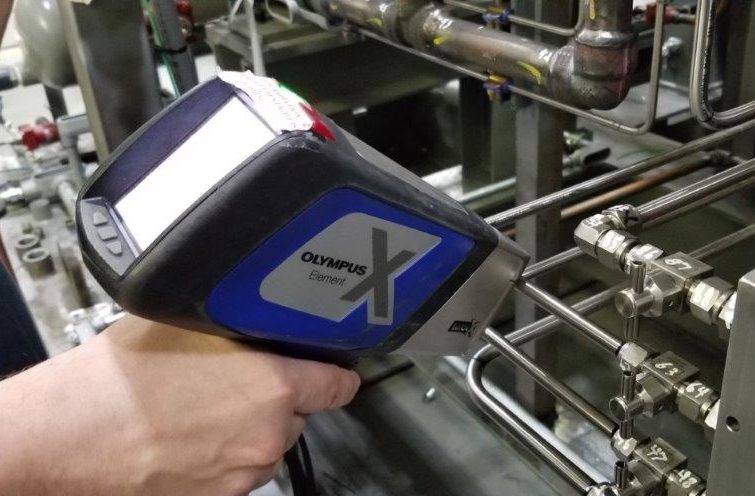 Positive Material Identification (PMI) is a nondestructive means of determining the chemical composition of metals. In a global sourcing environment, material can inadvertently be mixed up and cause serious issues while in service.
Positive Material Identification (PMI) is a nondestructive means of determining the chemical composition of metals. In a global sourcing environment, material can inadvertently be mixed up and cause serious issues while in service.
Using Positive Material Identification, RNDT Inc. can quickly and accurately determine the chemical composition of many different metals. RNDT has the newest technology when it comes to X-ray fluorescence units.
RNDT technicians are highly trained and certified. We are prepared to provide Positive Material Identification services anywhere in the United States.
Have a question?
Talk to an RNDT Level III inspector for free.
Call 1-800-505-7638 today!
X-ray fluorescence (XRF) is the emission of characteristic “secondary” (or fluorescent) X-rays from a material that has been excited by bombarding with high-energy X-rays or gamma rays. The phenomenon is widely used for elemental analysis and chemical analysis, particularly in the investigation of metals, glass, ceramics and building materials, and for research in geochemistry, forensic science and archaeology.
Underlying Physics
When materials are exposed to short-wavelength X-rays or to gamma rays, ionisation of their component atoms may take place. Ionisation consists of the ejection of one or more electrons from the atom, and may take place if the atom is exposed to radiation with an energy greater than its ionisation potential. X-rays and gamma rays can be energetic enough to expel tightly held electrons from the inner orbitals of the atom. The removal of an electron in this way renders the electronic structure of the atom unstable, and electrons in higher orbitals “fall” into the lower orbital to fill the hole left behind. In falling, energy is released in the form of a photon, the energy of which is equal to the energy difference of the two orbitals involved. Thus, the material emits radiation, which has energy characteristic of the atoms present. The term fluorescence is applied to phenomena in which the absorption of radiation of a specific energy results in the re-emission of radiation of a different energy (generally lower).
References
- Beckhoff, B., Kanngießer, B., Langhoff, N., Wedell, R., Wolff, H., Handbook of Practical X-Ray Fluorescence Analysis, Springer, 2006, ISBN 3-540-28603-9
- Bertin, E. P., Principles and Practice of X-ray Spectrometric Analysis, Kluwer Academic / Plenum Publishers, ISBN 0-3063-0809-6
- Buhrke, V. E., Jenkins, R., Smith, D. K., A Practical Guide for the Preparation of Specimens for XRF and XRD Analysis, Wiley, 1998, ISBN 0-471-19458-1
- Jenkins, R., X-ray Fluorescence Spectrometry, Wiley, ISBN 0-4712-9942-1
- Jenkins, R., De Vries, J. L., Practical X-ray Spectrometry, Springer-Verlag, 1973, ISBN 0387910298
- Jenkins, R., R.W. Gould, R. W., Gedcke, D., Quantitative X-ray Spectrometry, Marcel Dekker, ISBN 0-8247-9554-7
- Van Grieken, R. E., Markowicz, A. A., Handbook of X-Ray Spectrometry 2nd ed.; Marcel Dekker Inc: New York, 2002; Vol. 29; ISBN 0-8247-0600-5
RNDT Inc. provides nondestructive testing, industrial radiography, magnetic particle testing and more. RNDT, Inc. is an A2LA ISO-17025 accredited commercial testing laboratory headquartered in Johnstown, PA. Our field & laboratory services are offered to all industries. RNDT provides nondestructive testing in the form of industrial x-ray testing (industrial radiography), positive material identification (PMI), liquid penetrant, magnetic particle and ultrasonic testing and visual (CWI) inspections to most all industries. RDNT employs highly trained and experienced nondestructive testing professionals that hold current certifications conforming to the requirements of ASNT SNT-TC-1A & CP-189, National Aerospace Standard NAS-410 Rev. 3, Pressure Equipment Directive 97/23 EC for PED projects. These certifications satisfy global requirements for nondestructive testing personnel.
